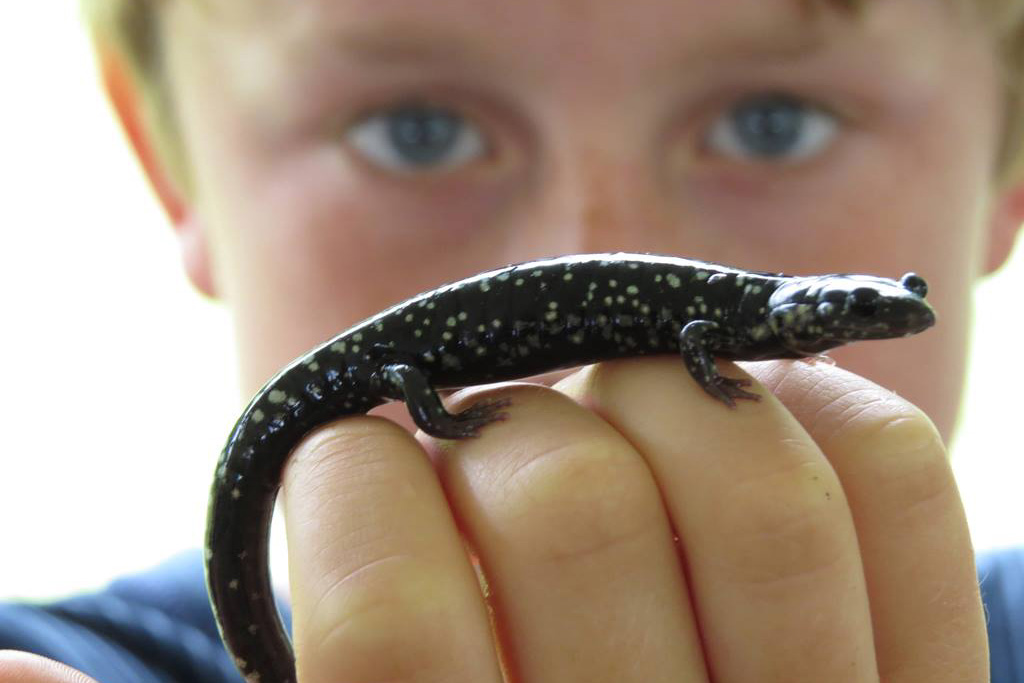To commemorate the National Park Service’s 100th year, the NPS is holding a series of so-called “BioBlitzes” at park sites around the country. So what exactly is a “BioBlitz?” And is it as nerdy as it sounds? We sent our own Julie Grant to the event at Cuyahoga Valley National Park in northeast Ohio to find out.
I didn’t even bother trying to get the older kids out of bed early on a wet Saturday morning—especially to tromp around outside for something with a weird name. But I roused my 7-year-old with the promise of pancakes and the chance to see wildflowers. Then, in full rain gear, we headed out to the park.
We walk past a pond covered in lily pads to join a small crowd of people milling around, some ducking under a canopy to escape the drizzle. Luckily, we also find someone who looks like she might know what we’re supposed to do—naturalist Nichole Houze, who, in a move fitting for 2016, directs us to kick off this nature walk by turning to our smartphones.
LISTEN: “The Sounds of a National Park BioBlitz”
She has us download an app called iNaturalist, and it lets everyone in the group share pictures, identify plants and document locations. This is the core of what a BioBlitz is all about: Spending the day, cataloging as many species as possible that we find in the park.
After signing in, we connect with two projects—the Cuyahoga Valley BioBlitz and the nationwide parks BioBlitz. Some groups will be looking for birds. Others will be scoping out fish or bats. Our group is focused on plants. And everything we upload is added to the big collection of what other people find at BioBlitzes around the country.
It’s our job to upload pictures of the plants we see and try to figure out what species they might be. Naturalist Nichole Houze gives us some books and old-school plant field guides to help with the identification part. And if we don’t know exactly what something is, the app can tag something so other scientists can help us ID it later.
Transformed into a crew of citizen scientists, we walk down a wooded path next to the pond, separating into groups of two or three. People peek around trees, ducking low, getting close to plants and taking photos; then standing with their phones, to upload and identify.

Sunset at Ledges Overlook at Cuyahoga Valley National Park. Cuyahoga Valley is one of dozens of national parks hosting “BioBlitz” nature surveys to document park biodiversity for the National Park Service’s 100th anniversary. Photo: Yi-Liang Liu via Flickr
My daughter can hardly believe I’ve given her my phone to use. She photographs horsetail by the parking lot, cattails by the water. And after a short walk, she crouches to get a close look at some tiny yellow flowers.
Nichole Houze hunkers down next to her, opening a field guide to the appropriate section.
“This looks like yellow stargrass; I actually haven’t seen that yet today,” Houze says. “Yellow flowers, a half inch to three-quarters inch wide. That looks correct. Leaves grasslike. Does this look like grass to you?
My daughter nods.
“Awesome—yellow stargrass. That’s a new one for us. You’ve got really good eyes.”
My 7-year-old glows at the compliment, then looks around for her next plant. Houze helps another mother-daughter team identify a yellow-and-red flower called wood betany. The mother says her daughter actually invited her to come.
“We live right outside the park, and we enjoy the park so much,” she says. “We’re plant lovers, and it just sounded like a nice thing to do.”
During the BioBlitz weekend here at Cuyahoga Valley, people participated in more than 100 plant and animal surveys—recording more than 3,000 observations of everything from algae and mosses to insects and frogs. Nationally, about 40,000 observations were uploaded to iNaturalist from national parks around the country. The information about what exists in the parks will be made public and is expected to be useful for all kinds of research projects.
###
Want to learn more about the National Park Service’s BioBlitz project? Or connect with a BioBlitz near you? Check out this site from the NPS.



